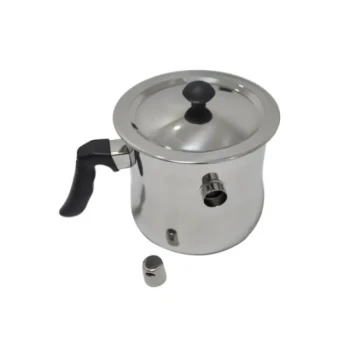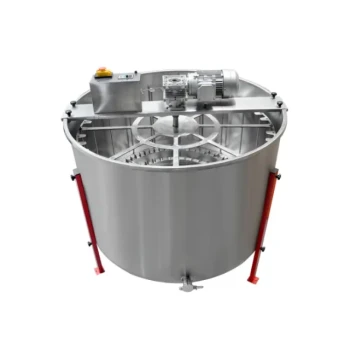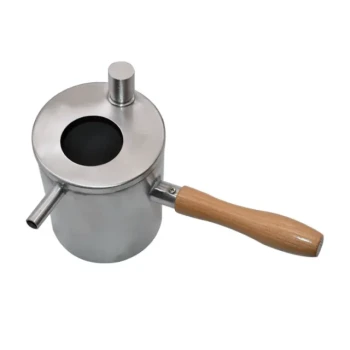The recommended procedure for floating wax extraction is a simple, gravity-based technique ideal for small-scale beekeepers. It involves breaking the honeycomb into small pieces inside a sealed container, allowing it to sit for several days as the lighter wax floats to the top, and then skimming the wax off before straining the honey below.
The core challenge for many beekeepers is separating honey from comb without expensive equipment. The floating wax method solves this by using the natural density difference between honey and beeswax, relying on patience and gravity rather than machinery to achieve a clean separation.
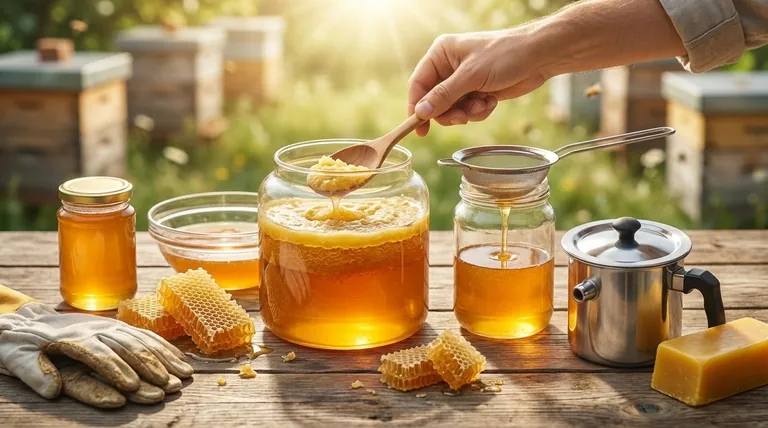
The Principles of the Floating Wax Method
This technique works by leveraging basic physics. Understanding the "why" behind the process ensures you get the best results with minimal effort.
Leveraging Density Differences
Honey is significantly denser than beeswax. Just as oil floats on water, beeswax will naturally float on honey. This fundamental property is the engine of the entire process.
The Role of Gravity and Time
This is a passive extraction method. By leaving the mixture undisturbed, gravity has time to pull the heavier honey to the bottom of the container while the lighter wax particles slowly migrate to the top.
Why Breaking the Comb is Crucial
Simply placing a whole comb in a bucket won't work efficiently. Breaking the comb into small pieces dramatically increases the surface area, opening up the individual wax cells and allowing the honey to flow out and separate freely.
A Step-by-Step Guide to Extraction
Follow these steps precisely for clean, well-filtered honey. The key ingredient is patience.
Step 1: Prepare the Comb
Break your honey-filled combs into small pieces. Place them into a clean, food-grade plastic container that has an airtight lid.
Step 2: The Settling Period
Seal the container airtight and place it in a clean, dry location. Let it sit undisturbed for a few days. The exact time depends on the ambient temperature, but you will see a distinct layer of wax forming at the top.
Step 3: The Initial Skim
Once the wax has formed a clear layer on the surface, open the container. Use a clean spoon or spatula to carefully skim this primary wax layer off the top of the honey.
Step 4: Filtration and Straining
Pour the remaining honey through a filter to remove any smaller, suspended wax particles. You can use a dedicated honey sieve, a new nylon stocking, or a clean, fine-mesh filter cloth stretched over another container.
Step 5: The Final Rest
After the initial straining, cover the honey and let it rest for another 24 hours. This allows the very finest wax particles or air bubbles that made it through the filter to rise to the surface.
Step 6: Final Skim and Bottling
Perform one last, careful skim to remove the final bits of wax from the surface. Your honey is now ready to be transferred into jars for storage, consumption, or sale.
Understanding the Trade-offs
While simple and effective, the floating wax method is not without its limitations. It's important to know when it is—and isn't—the right choice.
Simplicity vs. Speed
The primary benefit is its simplicity and low cost. However, it is significantly slower than mechanical methods like centrifugation, taking days instead of hours.
Efficiency and Yield
This method may leave more residual honey in the wax compared to using a honey press or an extractor. It is effective but may not provide the absolute maximum yield from a harvest.
Comparison to Other Methods
Compared to pressing, which uses force to squeeze honey out, this method is less labor-intensive. Compared to centrifugation, the commercial standard, it requires no investment in specialized, expensive machinery.
Making the Right Choice for Your Goal
The best extraction method depends entirely on your scale, budget, and priorities.
- If your primary focus is low cost and simplicity: The floating wax method is the perfect choice, requiring only patience and basic containers.
- If your primary focus is maximizing honey yield from the comb: Investing in a honey press will apply physical force to extract more honey than gravity alone.
- If your primary focus is speed and efficiency for a larger harvest: Centrifugal extraction is the industry standard for processing many frames quickly, but it requires a significant initial investment.
By understanding these principles, you can confidently extract your liquid gold using the method that best fits your beekeeping journey.
Summary Table:
| Step | Action | Key Detail |
|---|---|---|
| 1. Prepare | Break comb into pieces | Increases surface area for honey to flow out |
| 2. Settle | Let sit undisturbed for days | Wax floats to top, honey sinks to bottom |
| 3. Skim | Remove the top wax layer | Use a clean spoon or spatula |
| 4. Filter | Strain honey through a sieve | Removes finer wax particles |
| 5. Final Rest | Let honey sit for 24 hours | Allows finest particles to rise |
| 6. Bottle | Skim final bits and jar honey | Ready for storage or sale |
Ready to scale up your honey harvesting?
The floating wax method is perfect for small batches, but commercial apiaries and distributors need efficient, high-yield solutions. HONESTBEE supplies professional beekeeping equipment—including honey extractors, presses, and filters—to maximize your harvest efficiency and profitability.
Contact our experts today to discuss the best equipment for your operation's scale and goals.
Visual Guide
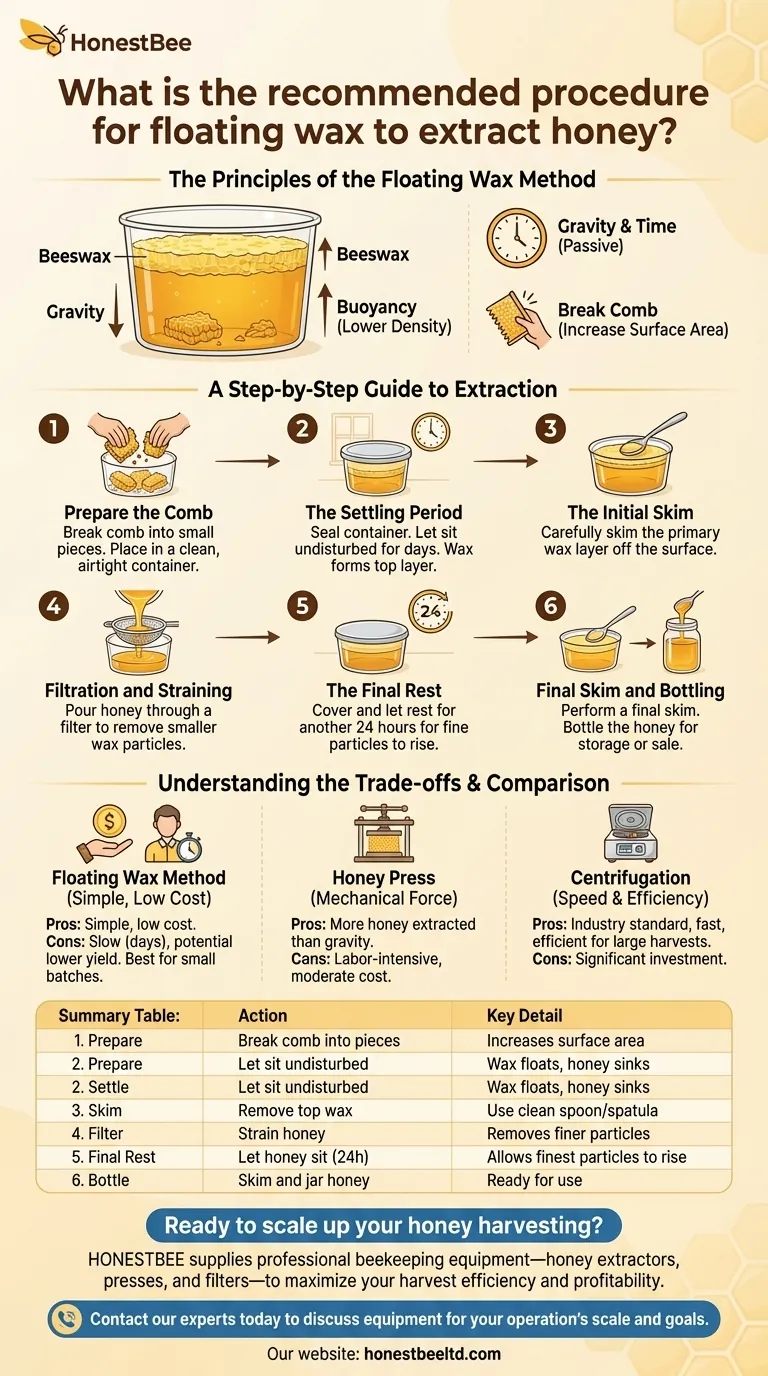
Related Products
- Beeswax Melter for Candle Making Honey Bee Wax Melter
- HONESTBEE 6 Frame Three Use Electric Honey Extractor for Beekeeping
- 6 Frame Manual Stainless Steel Honey Extractor Beekeeping Equipment
- HONESTBEE 3-Frame Manual Acrylic Honey Extractor
- Honey Wax Separating Wax Press with Metal Screw Wax Separator Machine
People Also Ask
- What makes polyurethane foam environmentally friendly? The Surprising Benefits of a Durable, Inert Material
- What is the recommended temperature range for melting beeswax? Achieve Perfect Quality & Safety
- How does a steam wax melter work? A Fast, Efficient Method for High-Quality Wax
- How do water jacket melters function? Achieve Gentle, Scorch-Free Melting for Sensitive Materials
- What are the benefits of using a professional wax melter? Achieve Consistent, Scalable, and Safe Production
